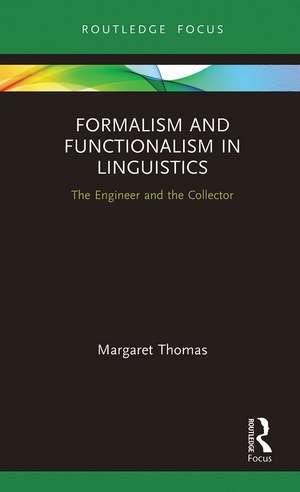Formalism and Functionalism in Linguistics: The Engineer and the Collector: Routledge Focus on Linguistics
Autor Margaret Thomasen Limba Engleză Paperback – 31 mar 2021
| Toate formatele și edițiile | Preț | Express |
|---|---|---|
| Paperback (1) | 181.99 lei 6-8 săpt. | |
| Taylor & Francis – 31 mar 2021 | 181.99 lei 6-8 săpt. | |
| Hardback (1) | 348.82 lei 6-8 săpt. | |
| Taylor & Francis – 15 aug 2019 | 348.82 lei 6-8 săpt. |
Preț: 181.99 lei
Nou
Puncte Express: 273
Preț estimativ în valută:
34.84€ • 36.21$ • 28.89£
34.84€ • 36.21$ • 28.89£
Carte tipărită la comandă
Livrare economică 05-19 februarie 25
Preluare comenzi: 021 569.72.76
Specificații
ISBN-13: 9780367787844
ISBN-10: 0367787849
Pagini: 126
Dimensiuni: 138 x 216 x 2 mm
Greutate: 0.15 kg
Ediția:1
Editura: Taylor & Francis
Colecția Routledge
Seria Routledge Focus on Linguistics
Locul publicării:Oxford, United Kingdom
ISBN-10: 0367787849
Pagini: 126
Dimensiuni: 138 x 216 x 2 mm
Greutate: 0.15 kg
Ediția:1
Editura: Taylor & Francis
Colecția Routledge
Seria Routledge Focus on Linguistics
Locul publicării:Oxford, United Kingdom
Public țintă
Postgraduate and UndergraduateCuprins
Table of Contents
Acknowledgements
Introduction
Chapter 1 Defining ‘Formalism’ and ‘Functionalism’
1.1 Starting Out
1.2 Defining the Terms
1.3 The Engineer and the Collector
1.4 Two Examples
1.5 On the Architecture of Formalism Versus Functionalism
References
Chapter 2 Background to the Current Debate
2.1 Is There a Starting Point?
2.2 Before the Twentieth Century
2.3 Twentieth-Century Formalist Linguistics to 1950
2.4 Twentieth-Century Functionalism from the Prague Circle to Pike
2.5 Why the Background Matters
References
Chapter 3 Contemporary Formalist Linguistics
3.1 The Internal Structure of Modern Formalism
3.2 What Makes Modern Formalism Formalist?
3.2.1 Early Transformational Grammar
3.2.2 Principles and Parameters
3.2.3 The Minimalist Program
3.2.4 The Common Formalist Character of Generative Grammar
3.3 Diversity Within Contemporary Formalism
References
Chapter 4 Contemporary Functionalist Linguistics
4.1 The Internal Structure of Modern Functionalism
4.2 The Scope of Modern of Functionalism
4.2.1 Systemic Functional Linguistics
4.2.2 Langacker’s Cognitive Grammar
4.2.3 Talmy Givón
4.3 Taxonomies of Modern Functionalist Linguistics
4.4 Graphic Style in Modern Formalism and Functionalism
References
Chapter 5 Formalism and Functionalism in Action
5.1 Applying Formalism and Functionalism
5.2 In the Analysis of Syntactic Phenomena
5.2.1 Word Order
5.2.2 Transitivity
5.3 In Conceptualization and Study of Child Language Learning
5.4 In Debate About the Origin of Human Language
5.5 Gaps, Overlap, and Combat Between Formalism and Functionalism
References
Chapter 6 Formalism and Functionalism Juxtaposed
6.1 Formalism and Functionalism in Silhouette
6.2 Face to Face
6.2.1 In Conversation
6.2.2 How Formal Is Functionalism?
6.2.3 How Functionalist Is Formalism?
6.3 Side by Side
6.3.1 Explanation
6.3.2 (Non)complementarity
6.4 Back to Back
References
Chapter 7 Conclusion
7.1 Engineers and Collectors, Revisited
7.2 Portrait of a Linguistic Mindset
7.3 Formalism and Functionalism Face the World Online
References
Appendix Characteristics of Formalism Versus Functionalism
Index
Acknowledgements
Introduction
Chapter 1 Defining ‘Formalism’ and ‘Functionalism’
1.1 Starting Out
1.2 Defining the Terms
1.3 The Engineer and the Collector
1.4 Two Examples
1.5 On the Architecture of Formalism Versus Functionalism
References
Chapter 2 Background to the Current Debate
2.1 Is There a Starting Point?
2.2 Before the Twentieth Century
2.3 Twentieth-Century Formalist Linguistics to 1950
2.4 Twentieth-Century Functionalism from the Prague Circle to Pike
2.5 Why the Background Matters
References
Chapter 3 Contemporary Formalist Linguistics
3.1 The Internal Structure of Modern Formalism
3.2 What Makes Modern Formalism Formalist?
3.2.1 Early Transformational Grammar
3.2.2 Principles and Parameters
3.2.3 The Minimalist Program
3.2.4 The Common Formalist Character of Generative Grammar
3.3 Diversity Within Contemporary Formalism
References
Chapter 4 Contemporary Functionalist Linguistics
4.1 The Internal Structure of Modern Functionalism
4.2 The Scope of Modern of Functionalism
4.2.1 Systemic Functional Linguistics
4.2.2 Langacker’s Cognitive Grammar
4.2.3 Talmy Givón
4.3 Taxonomies of Modern Functionalist Linguistics
4.4 Graphic Style in Modern Formalism and Functionalism
References
Chapter 5 Formalism and Functionalism in Action
5.1 Applying Formalism and Functionalism
5.2 In the Analysis of Syntactic Phenomena
5.2.1 Word Order
5.2.2 Transitivity
5.3 In Conceptualization and Study of Child Language Learning
5.4 In Debate About the Origin of Human Language
5.5 Gaps, Overlap, and Combat Between Formalism and Functionalism
References
Chapter 6 Formalism and Functionalism Juxtaposed
6.1 Formalism and Functionalism in Silhouette
6.2 Face to Face
6.2.1 In Conversation
6.2.2 How Formal Is Functionalism?
6.2.3 How Functionalist Is Formalism?
6.3 Side by Side
6.3.1 Explanation
6.3.2 (Non)complementarity
6.4 Back to Back
References
Chapter 7 Conclusion
7.1 Engineers and Collectors, Revisited
7.2 Portrait of a Linguistic Mindset
7.3 Formalism and Functionalism Face the World Online
References
Appendix Characteristics of Formalism Versus Functionalism
Index
Descriere
This volume is a concise introduction to the lively ongoing debate between formalist and functionalist approaches to the study of language.













